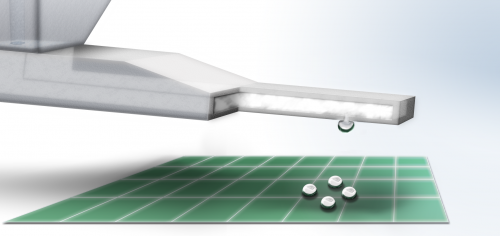Microscopic fountain pen to be used as a chemical sensor

The Atomic Force Microscope (AFM), which uses a fine-tipped probe to scan surfaces at the atomic scale, will soon be augmented with a chemical sensor. This involves the use of a hollow AFM cantilever, through which a liquid - in this case mercury - is passed under pressure. The droplet of mercury at the tip acts as a sensor. This microscopic fountain pen was developed by researchers at the University of Twente's MESA+ Institute for Nanotechnology.
An AFM's cantilever has a fine tip that can be used to map surfaces at the nanoscale. The movements of the tip are monitored using laser light reflected from the cantilever. If you could manufacture a hollow cantilever and pass a liquid through it, as happens in a fountain pen, then you could kill two birds with one stone. In addition to mapping surfaces, you could also use it to make highly localized measurements of the concentration of specific chemicals. This concept was the brainchild of Dr Peter Schön, a researcher who leads the "Enabling Technologies" Strategic Research Orientation at MESA+
The liquid selected was mercury, as it has the ideal properties for this purpose, such as an extremely clean surface. The researchers have created a cantilever with a microscopic tube running through it. The tube's lining has special mechanical properties, to contain the mercury as it is pumped through under high pressure (6 bar). Using this system, it has proved possible to create a perfect droplet at the tip. The droplet itself is the sensor, moreover it can easily be replaced in situ by a new sensor - the next droplet. It is also important that electrical current is only conducted through the mercury in the microscopic tube and not via parts of the cantilever, so as not to affect the measurement result. This goal, too, was successfully achieved.
A sensor of such exquisite sensitivity can be used to measure concentrations of specific chemicals on biomolecules and biomembranes, for example. It can also be used in combination with AFM, to make highly localized measurements of corrosion while at the same time gathering other information about the surface in question. This makes for a particularly powerful combination of measurement methods.
Details of the fountain pen's mechanism of action were recently published in Analytical Chemistry. The researchers are now focusing on ways of combining this technique with an AFM tip. They are also developing a technique for efficiently releasing the used mercury droplet to make way for a "clean" sensor.
Journal information: Analytical Chemistry
Provided by University of Twente





















